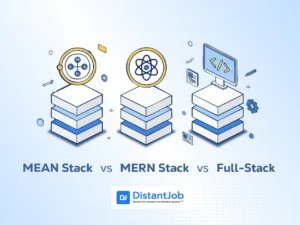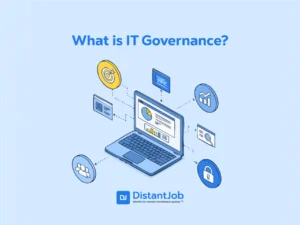On September 19, 2025, Trump’s H-1B fee took many companies by surprise, especially those who hire full-time, in-house foreign developers. H-1B’s new fee charges any company that petitions for an immigrant visa by $100,000.
After surviving its shockwaves, how will Trump’s H-1B fee impact your company and the software development job market?
We wrote this guide to aid your company in dealing with the new job market landscape.
H-1B New Fee and Rules
A one-time fee of $100,000 for the H-1B visa is now in effect for all petitions filed after September 21, 2025. This fee is not an annual charge. Furthermore, the new cost does not apply to existing H-1B visas or their current beneficiaries.
The determining factor for the fee is whether the worker is inside or outside the United States; the fee only applies to workers outside America. Finally, the new H-1B fee will take effect immediately for the 2027 lottery.
Potential Raise in Minimum Wage for H-1B Workers
Trump’s H-1B fee answers a complaint from the Department of Labor, which has been trying to raise the minimum wage of H-1B workers. The Department tried to increase the minimum wage in October 2020 and in January 2021. It’s unclear whether the DOL will try it again after the fee.
What is the H-1B Visa?
The H-1B visa permits educated foreign professionals to work temporarily in the U.S. in “specialty occupations.” U.S. companies must petition the government, demonstrating that the specific expertise required for the specialty occupation cannot be found in America. These visas are then allocated to eligible professionals through a lottery system.
The Original Intention of H-1B
In 1990, President George Bush signed a bill into law, facilitating the immigration of highly skilled workers (e.g., scientists, engineers, professors) and addressing potential labor shortages in highly specialized fields.
In the H-1B visa process, as intended, a company had to prove that it had looked for a suitable candidate in America first. Only after a scrutinizing recruitment process, a company made a petition to the government, and they were able to hire a highly skilled global employee for three years, with a potential extension of an additional six years.
All potential immigrant candidates should have at least a bachelor and they were selected by lottery. In short, the ultimate goal was to help small and medium American businesses with real needs find unicorn employees unavailable in the U.S.
The Misuse of the H-1B Visa
Big companies saw the H-1B as a huge opportunity to cut costs. For example, they could hire, let’s say, 5,000 H-1B immigrant developers (who will accept 50% of the salary benchmark) and lay off 15,000 American developers. According to the US Citizenship and Immigration Services, the FAAMG were among the companies that employed the most H-1B visa holders in 2024.
If you ask me, this might be a reason why big tech companies have been showing massive profits in their stocks after massive layoffs. According to Quartz, Microsoft posted sales of nearly $80 billion and a net income of $27 billion in the most recent quarter. Up to now, Microsoft has also laid off 15,000 developers in September 2025.
To bypass the proof requirement of searching first for American candidates, companies hire an agency to do a ghost job recruitment. These agencies claim they haven’t found anyone in America to fill the role, so they can hire an immigrant employee for 50% of the average salary in the U.S..
If you are a job seeker, maybe you have already fallen for such a scam. They interview you, planning to reject you beforehand, giving the company an excuse to hire cheaper labor through H-1B.
Who are the H-1B visa workers?
The average H-1B visa workers are full-time, in-house, on-site Indian software developers. According to the American Immigrant Council, nearly 70% of H-1B immigrants are Indians, and 65% of the H-1B workers had computer-related jobs in 2023. CBS states that “more H-1B visas were granted to software developers last year than for any other position”.
These workers typically accept a lower salary than their American counterparts, resulting in a lower cost for their employers. And as their presence in the U.S. is conditioned on their companies, they are unlikely to ask for a raise.
What will be the Impact of the H1-B’s New Fee on the Tech Market?
The H1-B New Fee’s impact will be felt mostly on businesses that need high-quality on-site workers, especially small companies (with hardly enough budget) and universities. Cheaper international workers won’t be as available as it was for on-site roles. The companies will be more inclined to outsource their staff, rather than spending money on on-site developers.
Big Techs were alarmed, sending messages to their employees, telling them to return as soon as possible to their American homes. At that time, it was unclear if the new fee would affect former beneficiaries of the H-1B visa.
On the other hand, American developers will be safer for on-site jobs. The massive tech layoffs won’t hit them as easily as before. That being said, companies might feel tempted to outsource their workforce rather than hire American workers on-site. Current offshore outsourcing already saves costs by hiring remotely rather than bringing workers to the US.
According to Statista, 66% of the companies already outsource their workforce. In fact, Forbes lists outsourcing and artificial intelligence as the biggest threats to American white-collar workers rather than H-1B workers.
Should you hire an H-1B worker under the new fee?
The short answer is “no, not yet”. Any hiring or budget strategy developed around the $100,000 fee must account for the high risk of the Proclamation being blocked or overturned in the courts. Trump’s H-1B Fee Proclamation is expected to face immediate and aggressive legal challenges from tech lobbying groups (like the U.S. Chamber of Commerce) and immigrant advocacy organizations.
Unlike fees covering administrative costs, a punitive fee of this size is likely to be argued in court as an unlawful exercise of presidential authority (since only Congress can legislate new taxes or fees beyond cost recovery).
Potential alternatives for visas are L-1 (Intracompany Transfer), O-1 (Extraordinary Ability), and the Green Card Pathways (EB-1, EB-2, EB-3).
| Visa/Status | Relevance |
| L-1 (Intracompany Transfer) | For companies with international offices. Allows the transfer of foreign employees with specialized knowledge or managers/executives. Exempt from the H-1B cap and lottery. |
| O-1 (Extraordinary Ability) | Ideal for highly specialized “unicorn” developers or researchers who can prove they are at the top of their field (e.g., published, received awards, high salary). No annual cap. |
| Green Card Pathways (EB-1, EB-2, EB-3) | Mention the potential for sponsoring an employee for permanent residency (a Green Card) directly, often using an EB-2 National Interest Waiver (NIW) for exceptional talent, which bypasses the labor certification step. |
What about Offshore Outsourcing?
While offshore developers are as skilled as any other developer, mass outsourcing them will be troublesome, because you won’t have a guarantee of your employees’ quality of work or cultural fit. It’s also not advisable to let your workforce belong to another company entirely.
Conclusion
It’s the end of the cheap, in-house foreign labor. President Trump’s new $100,000 H-1B fee, effective September 19, 2025, eliminates the former H-1B cost-saving incentive for companies. While protecting American on-site developers, it challenges both businesses and universities. The threat to American white-collar jobs may shift to mass offshore outsourcing and AI.
Caution is advised due to immediate legal challenges; any long-term talent strategy based on this fee is risky. Companies should explore alternatives like L-1, O-1, and Green Cards to avoid expensive H-1B workers. The market is redefining “in-house” and “on-site.”
What if you had a better alternative than immigration to hire full-time global developers and save costs?
That’s what we do at DistantJob. We offer you the best remote talent across the world. A cultural fit, with every hard and soft skill of your heart’s desire. Lower your expenses without worrying about visa fees, compliance, and a paycheck; we will do that for you.
You only pay when you want to hire a developer, with a three-month guarantee to take your money back. No hidden fees and no fine print.
Call us today, and hire the developer of your dreams!
FAQ
It’s a one-time fee, according to the White House. Section 1(a) states that the entry of certain nonimmigrant workers is restricted, except for those whose petitions are accompanied or supplemented by a payment of $100,000. Section 2(a) clarifies that employers must make the payment “prior to filing an H-1B petition” on behalf of the alien. You only pay it once. White House press secretary Karoline Leavitt also confirms that it is a one-time fee.
The source of confusion is due to a statement from Commerce Secretary Howard Lutnick. In a conference call with reporters, he said: “If you have a very sophisticated engineer and you want to bring them in … then you can pay $100,000 a year for your H-1B visa.”
No. The fee only applies to H-1B petitions filed for a worker who is outside the United States at the time of the petition. The new cost does not apply to current H-1B visa holders, including those seeking extensions or transfers, as long as they are physically present in the U.S.
The one-time fee is in effect for all new H-1B petitions filed after September 21, 2025. It will also be a factor in the upcoming 2027 H-1B lottery for initial applications.
The current text of the proclamation does not provide a specific exemption based on the employer’s size or type (e.g., small businesses, non-profits, or educational institutions). This is why the impact is expected to be most severe for these groups, who lack the deep financial reserves of Big Tech.
This $100,000 charge is in addition to any pre-existing H-1B filing and compliance fees, such as the Fraud Prevention and Detection Fee ($500), the American Competitiveness and Workforce Improvement Act (ACWIA) fee (ranging from $750 to $1,500), and the Public Law 114-113 fee ($4,000 for H-1B dependent employers). This makes the total cost for certain petitions significantly higher than $100,000, no legal fees included.
The safest alternatives depend on the employee’s situation and skill set:
- L-1 Visa (Intracompany Transfer): If your company has foreign offices, the L-1 allows for the transfer of specialized knowledge workers or managers/executives. It is not subject to the annual cap or the new fee.
- O-1 Visa (Extraordinary Ability): Ideal for “unicorn” developers or researchers who can be proven to be at the top of their field (e.g., multiple awards, publications, exceptionally high salary). This visa has no annual cap and is a strong, though more demanding, option.
- Green Card Pathways (EB-1, EB-2, EB-3): For a long-term, permanent solution, sponsoring a Green Card through an employment-based petition is an option, bypassing the temporary H-1B status entirely.
- DistantJob: You can have both full-time and unicorn developers at the same time by hiring them remotely. This will save your costs, because you won’t have to pay them at the same salary rate as an American developer, nor spend money in immigration or legal fees. It will also increase your employees’ satisfaction, because the salary will be higher than what they receive in their homeland.
Legal challenges are anticipated because the fee is punitive rather than simply covering administrative costs. Critics and legal experts argue that a presidential proclamation cannot enact a tax or a fee of this magnitude (which effectively acts as a tax) without explicit authorization from Congress. Only Congress has the constitutional power to legislate new taxes beyond cost recovery.
It is unclear. While the fee addresses the Department of Labor’s (DOL) long-standing complaint about H-1B salaries undercutting American workers, the DOL has not yet acted to raise the minimum wage further after previous attempts. The new fee acts as a strong financial disincentive for companies to hire cheaper foreign labor, potentially achieving the effect of a wage increase without directly altering the minimum salary levels.





